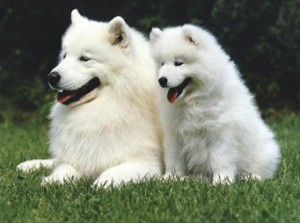Meet the Europeans – Denmark’s Native Breeds
114 – June 2017
text and illustrations by Ria Hörter
Many of today’s breeds originated in Europe. They were principally developed in Great Britain, Germany and France, but it would be hard to find any European country without a national dog breed. Meet the Europeans will explore the history of breeds on an old continent full of fanciers.
Denmark, A Small Country with Six Native Breeds
Danish Spitz – Danish-Swedish Farm Dog – Old Danish Pointing Dog
Danish Spitz – Dansk (Hvide) Spids
 The Spitz family is a group of breeds that share the same points: relatively small prick ears, tails carried over the back and more or less steep rears. The Danish Spitz is white (in Danish, hvide), about 19 inches (49 centimeters) at the shoulder. At first sight, the Danish Spitz resembles a small Samoyed. The breed is closely related to the German Spitz. Many fanciers believe that the Danish Spitz is a variety of the German Spitz or Dutch Keeshond, but others are convinced that the Danish Spitz is a breed in its own right. Scientists consider Spitz dogs to be one of the oldest, if not the oldest, canine companions that lived in our houses and were part of the family. Information about the breed can be confusing; other names, apart from Dansk (Hvide) Spids, are Grønlænderspids, Samojedspids and Ulvesspids (Wolfspitz).
The Spitz family is a group of breeds that share the same points: relatively small prick ears, tails carried over the back and more or less steep rears. The Danish Spitz is white (in Danish, hvide), about 19 inches (49 centimeters) at the shoulder. At first sight, the Danish Spitz resembles a small Samoyed. The breed is closely related to the German Spitz. Many fanciers believe that the Danish Spitz is a variety of the German Spitz or Dutch Keeshond, but others are convinced that the Danish Spitz is a breed in its own right. Scientists consider Spitz dogs to be one of the oldest, if not the oldest, canine companions that lived in our houses and were part of the family. Information about the breed can be confusing; other names, apart from Dansk (Hvide) Spids, are Grønlænderspids, Samojedspids and Ulvesspids (Wolfspitz).
The breed was known in the 1700s as an excellent little guard dog and good companion. In 1796-97 the breed was painted by Jens Juel (1745- 1802), a Danish artist who represents something close to the high point of 18th-century Danish portrait painting. Niels Ryberg (1725-1804), his son Johan Christian and daughter- in-law Engelke Ryberg (née Falbe) were portrayed with their lovely Danish Spitz. Ryberg was a trader, ship owner and landowner. In 1960, the painting was acquired by the National Gallery of Art in Copenhagen. The breed was first judged in 1922 when, out of 19 dogs, 12 had enough quality to be registered in a special stud book, the so-called X register. The heyday of the breed was in the 1930s; the Danish Spitz was a common dog at that time especially in Jutland–Jylland in Danish a peninsula in the northern part of Denmark.
And again, it was Jytte Weis who, in 1988 on behalf of the Danish Kennel Club, tried to restore the breed – as she had done with the Broholmer – by collecting old depictions and typical dogs.
Jack of All Trades
The breed is not associated with the Danish Spidshundeklubben (Spitz Dog Club) but there is a Selskabet for Dansk Spids, a club of fanciers that promotes this old breed. The Selskabet is a member of the Danish Kennel Club. In 2003, the Danish Kennel Club, published a provisional breed standard.
In August 2013, the Journal of Animal Science published an article about the Danish breeds and came to the conclusion that the Danish Spitz had the most genetic variations compared to the other native Danish dog breeds.
The Danish Spitz is a jack of all trades: guard dog, companion dog and working dog. But above all, he is a friendly and curious little dog.
Click here to read the complete article114 – June 2017
Short URL: http://caninechronicle.com/?p=126733
Comments are closed











